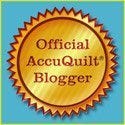You might remember that last month I took a workshop with Spikey Deb Karasik. I'd never taken a paper piecing class, so I figured why not learn from one of the masters. Sure, you can learn from a book, or from a video on the Internet, but one thing you won't learn that way is that there are lots of cool toys out there to make your paper piecing life a bit easier.
My favorite is this rolling 'iron'. If you're lucky enough to have an old time hardware store, you'll find one of these in the wallpaper hanging department. It's a seam roller, and that name applies to quilting as well. Instead of whipping out the iron for all your little seams you want pressed in one direction, you just roll over them. First, give the sewn seam a roll to set it, and then you can open the seam, or press it to the left or the right side by giving it another roll. Fast, no hot iron sucking up the kilowatts, no burned fingers...it's brilliant..
Just a few generic paper piecing hints.....it helps to stack your pieces in the order they will be sewn, with the paper foundation on the top. This way you just pick up the paper, then the first piece on the stack is the first piece you sew down, then the next is second., etc. No worries if you've got the right color in your hand. You'll also save a load of time if you cut all of your pieces uniformly. It's not going to waste a whole lot of fabric but the time you will save cutting is well worth it. Figure out what size square is going to work across the foundation and just cut everything that size....bonus tip.....stack the fabric in the piecing order before you cut it and you'll simply need to just pick up the fabric stack, lay the foundation on the top, and off you go.

Set your stitch length a tad smaller than normal. You don't want to be backstitching to anchor your thread on every little piece, so if you use a smaller stitch, it's less chance you're going to pull those seams apart while you're working.
When you've got spikes, when you get to the points, stitch just inside the guidelines on your foundation. The last thing you want to do is cut those spike tips off as you add more fabric. This will insure that doesn't happen.
It helps to make a good crease when you're folding back your foundation paper to cut. And it helps to be accurate. What I'm using as a fold-back guide here is simply a piece of template plastic. Folding your foundation paper back on this not only gives you a crisp, accurate crease, but it also.....
Now let's talk about my 'splurge' tool. Show of hands....how many of you are concerned about accurate quarter-inch seams? Well if you've stacked the Post-Its, used the stick back vinyl strips, purchased quarter inch feet with or without guides, and still have trouble, then you need to get one of these.
It's important to keep in mind that unless you have a top of the line machine with laser needle positioning, you can't really count on guides. If your needle position is off slightly, that quarter inch foot you're butting the edge of your fabric against isn't going to yield a quarter inch seam. Your presser foot is never going to move, but the position of your needle will. If you've got a Bernina, you see this every time you turn on your machine--the needle aligns itself --it takes a little jog to the right and then it jogs back to 'center'. And that 'center' may or may not be accurate. It helps to determine this if you have a single--hole needle plate, but if not, take my word for it that your needle could be slightly misaligned...particularly if you haven't had your machine serviced in a while.
That's where this handy Ideal Seam Gauge and Guide comes into play.
Show of hands again.....who has sewn a pattern that called for 'a scant quarter inch' seam? Who the heck knows what a 'scant quarter inch' seam is? Not to mention how do you maintain the same amount of 'scant' throughout your project?
Well, there's a setting on this tool for 'Scant 1/4". This is one of the reasons I bought this (and I loved the 'scant 1/4"' setting so much, that I also bought one of these for my sister, who once asked me how you tell what a scant 1/4" seam was...I didn't have a clue :).)
What you do is slide this gauge under your presser foot and insert your needle in the hole of the desired seam width you want to use.
Drop your presser foot to hold the tool in place, and take the Seam Guide and butt it up against the gauge. The Seam Guide has that magic sticky stuff on the back of it...the stuff that the Sew Slip sewing mats have on them. It allows the Guide to grip to your machine, but you can easily peel it off without leaving a residue, and if it looses it's stickiness, you just run water on it to clean off any lint and dust and it will stick again. (I keep the protective plastic covering from mine to put back over it when I'm finished using it).
Once you've assured that it's firmly positioned, lift your presser foot, needle up, and remove the gauge.
Align your fabric edge with the guide, and you are guaranteed to have a perfect (for your machine) 1/4", scant 1/4", or whatever seam allowance you set up for.
Which is kind of important when you've got lots of seams that need to be equal and not cut off points, and yield designs where the shapes are all the same size.
If any of the seams are off, this isn't going to look like this when I finally finish it :)
Before you marvel at my progress, I will tell you that after taking these photos I set aside my paper piecing project to move on to a new Baltimore applique project. We'll talk applique next post. I took a workshop with Barbara Burnham (author of The Baltimore Garden Quilt). Let's just say I've changed up how I use freezer paper these days. Stay tuned.
Happy Monday!
































No comments:
Post a Comment
I appreciate and look forward to your comments. Thanks for reading. Happy quilting!